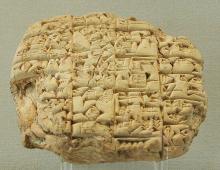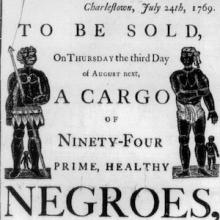Browse Primary Sources
Locate primary sources, including images, objects, media, and texts. Annotations by scholars contextualize sources.

Sumerian School Days
This tablet, from ancient Sumeria (as early as 2000 B.C.E.), details a day in the life of a school boy. Students learned by copying lessons on clay tablets, memorizing the lessons, and then reciting them for the school's headmaster (the "school father") or other teachers, monitors, and proctors of the school.
Jingle Bells, Batman Smells
This parodic folksong is representative of the "culture"—texts, toys, uses of technology, social practices, and shared meanings—young people create when they selectively incorporate commercial products into their peer activities.

Advertisement for Sale of Newly Arrived Africans
This image is of an advertisement for a nearly equal number of adults and children from Sierra Leone at a Charleston Auction. This image is important for several reasons, namely because one should see what an auction advertisement looks like, but also because the number of boys and girls is nearly equal to that of the number of men and women imported.
Etta Palm D’Aelders, "Discourse on the Injustice of the Laws in Favor of Men, at the Expense of Women" (30 December 1790)
Like many female activists, the Dutch woman Etta Palm D’Aelders did not explicitly articulate a program for equal political rights for women, though that would no doubt have been her ultimate aim. Instead she worked to bring about a change in morals and customs that would in turn foster a more egalitarian atmosphere for women.
Women's Petition to the National Assembly
This petition was addressed to the National Assembly sometime after the October 1789 march of women on Versailles. The authors were clearly well acquainted with the Declaration of the Rights of Man and Citizen, as well as with the many prior publications about the historical accomplishments of celebrated women.
Women Testify Concerning Their Participation in the October Days (1789)
The commission investigating the events of October 1789 also interrogated many women who had participated. Most of them denied any role in the violence, but they did explain their mixture of political and economic motives, citing the high price of bread and their desire to explain their situation to the National Assembly.
Stanislas Maillard describes the Women’s March to Versailles (5 October 1789)
Stanislas Maillard was a national guardsman known for having taken a leading role in the attack on the Bastille. In 1790 he testified before a commission established by the court in Paris to investigate the events of October 1789.
A Woman’s Cahier
This grievance was signed by a certain Madame B*** B*** whose identity is unknown. The provenance appears to be Normandy. Another version of this text, located and republished in the late nineteenth century, is signed by Marie, veuve de Vuigneras, also from Normandy.
Madame de Beaumer, Editorial, Journal des Dames (March 1762)
Madame de Beaumer (d. 1766) was the first of three women editors of the Journal des Dames, a newspaper founded in Paris in 1759 to encourage women to write seriously. Little is known about her, perhaps because she was a Calvinist and Calvinists in France had to marry and baptize their children clandestinely.
Article from the Encyclopedia: "Woman"
The article "Woman" was written by four contributors who considered the question from four angles: medicine and the history of opinions about women’s nature; writings about women’s place in the state and marriage; the social differences between men and women; and women’s legal status in different societies.
Military Suppression of Prairial
The Prairial insurrection of Year III (May 1795) would prove to be among the last major episodes of popular activism during the Revolution, due in part to the Convention’s forceful use of National Guard units, leading to the arrest of many activists and the execution of several popular leaders.
Women’s Activities during the Prairial Uprising
Popular radical activity continued throughout the period of the Terror (see Chapter 7) and did not end with 9 Thermidor.
Robespierre, "On Political Morality"
In this speech to the Convention, delivered on 5 February 1794, Robespierre offered a justification of the Terror.
The Maximum
In September 1793 the Convention furthered its role as the guarantor of the basic right to subsistence of all citizens by instituting price maximums on all essential consumer goods, especially foodstuffs, and on wages paid in the production of those goods.
The Law of Suspects
This law, passed on 17 September 1793, authorized the creation of revolutionary tribunals to try those suspected of treason against the Republic and to punish those convicted with death.
Decree against Profiteers
In July 1793, faced with a restive populace angered by continuing shortages of food in Paris, the Convention followed the lead of the sections in blaming the high price of bread on "profiteers" in the countryside, who were taking advantage of their fellow citizens by charging abnormally high prices for grain.
The Clergy as a Target: A Political Problem
Camille Desmoulins, an influential populist writer, here attacks the distinction between "active" and "passive" citizenry based on personal wealth, by pointing out that Christ himself would have been relegated to "passive" citizenry.
A Royal History
This 1790 article from the Journal Universel, a leading radical newspaper, recounts the long desperate history of the monarchy that ironically led the revolution.
Marat Attacks the Nobility
In this article, Marat characteristically expresses his concern that, although new governmental institutions had been created, they remained under the control of aristocratic influences, hostile to the Revolution. This fear that those in power were themselves lacking in sincerity and devotion to the people would become more pronounced in Marat’s articles as the Revolution continued.
Aristocratic Values
This 1789 article from the Révolutions de Paris, a leading radical newspaper, argues that the Revolution has not been achieved, because all of the changes to date could still be reversed.